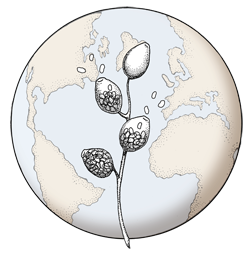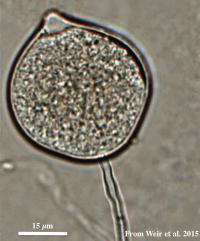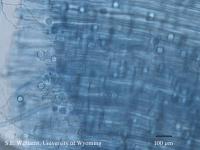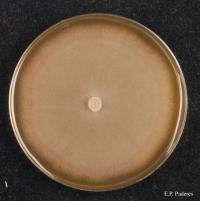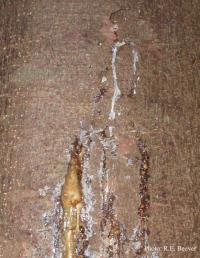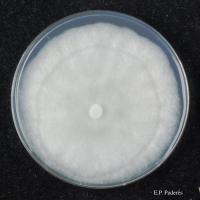Comparative gametangial morphology of Phytophthora Clade 5 species, with SEM (top) and light microscopy (bottom). P. heveae has smooth walled oogonia with funnel-shaped, amphigynous antheridia. P. agathidicida has mildly stipulate oogonia with globose amphigynous antheridia. P.cocois has mildly bullate oogonia with reflexed amphigynous antheridia. P. castaneae has coarsely bullate oogonium with rugose protuberances and narrow amphigynous antheridia (Weir et al. 2015).
Photo Gallery
|
Comparative gametangial morphology of Phytophthora Clade 5 species |
P. agathidicida sporangium Globose to ovoid-ellipsoid, papillate sporangium |
P. agathidicia disease symptoms on kauri Crown decline of mature kauri, with branchlets with little or no leaves |
|
P. agathidicida oospores Oospores of P. agathidicida in the roots of kauri seedlings inoculated with P. agathidicida. The root has been cleared with potassium hydroxide and bleached with peroxide, before being stained with Trypan Blue |
Tāne Mahuta “Lord of the Forest” kauri tree Tāne Mahuta “Lord of the Forest” is a giant kauri tree (approximately 47 metres in height) in the Waipoua Forest of Northland Region, New Zealand. Its age is unknown but is estimated to be between 1,250 and 2,500 years |
P. agathidicida growth on MEA Diffuse, non-patterned, colony morphology of ICMP 16471 (the original “Gadgil isolate”) after 10-days incubation at 20°C in the dark |
|
P. agathidicia oogonia P. agathidicida oogonia with SEM (top) and light microscopy (bottom) |
P. agathidicida growth on CMA Diffuse, non-patterned, colony morphology of ICMP 16471 (the original “Gadgil isolate”) after 10-days incubation at 20°C in the dark |
P. agathidicia sporangia Differentiation of the cytoplasm within papillate sporangia into acid fuchsin stained zoospores |
|
P. agathidicida lesion on kauri tree Gum oozing out of longitudinal lesion |
P. agathidicida lesion on kauri tree Advancing triangular lesion extending up the trunk of an 80 cm DBH kauri tree in the Huia Dam Site along Twin Peaks Track, Waitakere Regional Park |
P. agathidicia growth on PDA Colony morphology of ex-holotype ICMP 17027 after 10-days incubation at 20°C in the dark |

